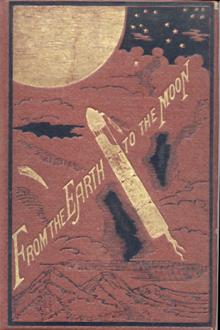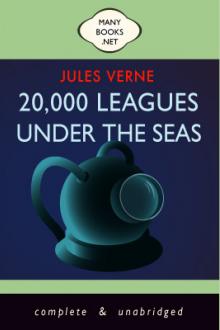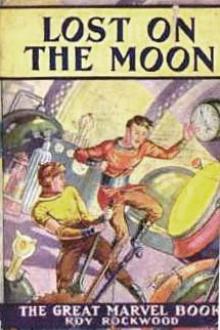From the Earth to the Moon by Jules Verne (electric book reader .TXT) 📖

- Author: Jules Verne
- Performer: -
Book online «From the Earth to the Moon by Jules Verne (electric book reader .TXT) 📖». Author Jules Verne
“Terrestrial volcanoes,” said Barbicane, “are but mole-hills compared with those of the moon. Measuring the old craters formed by the first eruptions of Vesuvius and Etna, we find them little more than three miles in breadth. In France the circle of Cantal measures six miles across; at Ceyland the circle of the island is forty miles, which is considered the largest on the globe. What are these diameters against that of Clavius, which we overlook at this moment?”
“What is its breadth?” asked Nicholl.
“It is 150 miles,” replied Barbicane. “This circle is certainly the most important on the moon, but many others measure 150, 100, or 75 miles.”
“Ah! my friends,” exclaimed Michel, “can you picture to yourselves what this now peaceful orb of night must have been when its craters, filled with thunderings, vomited at the same time smoke and tongues of flame. What a wonderful spectacle then, and now what decay! This moon is nothing more than a thin carcase of fireworks, whose squibs, rockets, serpents, and suns, after a superb brilliancy, have left but sadly broken cases. Who can say the cause, the reason, the motive force of these cataclysms?”
Barbicane was not listening to Michel Ardan; he was contemplating these ramparts of Clavius, formed by large mountains spread over several miles. At the bottom of the immense cavity burrowed hundreds of small extinguished craters, riddling the soil like a colander, and overlooked by a peak 15,000 feet high.
Around the plain appeared desolate. Nothing so arid as these reliefs, nothing so sad as these ruins of mountains, and (if we may so express ourselves) these fragments of peaks and mountains which strewed the soil. The satellite seemed to have burst at this spot.
The projectile was still advancing, and this movement did not subside. Circles, craters, and uprooted mountains succeeded each other incessantly. No more plains; no more seas. A never ending Switzerland and Norway. And lastly, in the canter of this region of crevasses, the most splendid mountain on the lunar disc, the dazzling Tycho, in which posterity will ever preserve the name of the illustrious Danish astronomer.
In observing the full moon in a cloudless sky no one has failed to remark this brilliant point of the southern hemisphere. Michel Ardan used every metaphor that his imagination could supply to designate it by. To him this Tycho was a focus of light, a center of irradiation, a crater vomiting rays. It was the tire of a brilliant wheel, an asteria enclosing the disc with its silver tentacles, an enormous eye filled with flames, a glory carved for Pluto’s head, a star launched by the Creator’s hand, and crushed against the face of the moon!
Tycho forms such a concentration of light that the inhabitants of the earth can see it without glasses, though at a distance of 240,000 miles! Imagine, then, its intensity to the eye of observers placed at a distance of only fifty miles! Seen through this pure ether, its brilliancy was so intolerable that Barbicane and his friends were obliged to blacken their glasses with the gas smoke before they could bear the splendor. Then silent, scarcely uttering an interjection of admiration, they gazed, they contemplated. All their feelings, all their impressions, were concentrated in that look, as under any violent emotion all life is concentrated at the heart.
Tycho belongs to the system of radiating mountains, like Aristarchus and Copernicus; but it is of all the most complete and decided, showing unquestionably the frightful volcanic action to which the formation of the moon is due. Tycho is situated in 43@ south latitude, and 12@ east longitude. Its center is occupied by a crater fifty miles broad. It assumes a slightly elliptical form, and is surrounded by an enclosure of annular ramparts, which on the east and west overlook the outer plain from a height of 15,000 feet. It is a group of Mont Blancs, placed round one common center and crowned by radiating beams.
What this incomparable mountain really is, with all the projections converging toward it, and the interior excrescences of its crater, photography itself could never represent. Indeed, it is during the full moon that Tycho is seen in all its splendor. Then all shadows disappear, the foreshortening of perspective disappears, and all proofs become white— a disagreeable fact: for this strange region would have been marvelous if reproduced with photographic exactness. It is but a group of hollows, craters, circles, a network of crests; then, as far as the eye could see, a whole volcanic network cast upon this encrusted soil. One can then understand that the bubbles of this central eruption have kept their first form. Crystallized by cooling, they have stereotyped that aspect which the moon formerly presented when under the Plutonian forces.
The distance which separated the travelers from the annular summits of Tycho was not so great but that they could catch the principal details. Even on the causeway forming the fortifications of Tycho, the mountains hanging on to the interior and exterior sloping flanks rose in stories like gigantic terraces. They appeared to be higher by 300 or 400 feet to the west than to the east. No system of terrestrial encampment could equal these natural fortifications. A town built at the bottom of this circular cavity would have been utterly inaccessible.
Inaccessible and wonderfully extended over this soil covered with picturesque projections! Indeed, nature had not left the bottom of this crater flat and empty. It possessed its own peculiar orography, a mountainous system, making it a world in itself. The travelers could distinguish clearly cones, central hills, remarkable positions of the soil, naturally placed to receive the chefs-d’oeuvre of Selenite architecture. There was marked out the place for a temple, here the ground of a forum, on this spot the plan of a palace, in another the plateau for a citadel; the whole overlooked by a central mountain of 1,500 feet. A vast circle, in which ancient Rome could have been held in its entirety ten times over.
“Ah!” exclaimed Michel Ardan, enthusiastic at the sight; “what a grand town might be constructed within that ring of mountains! A quiet city, a peaceful refuge, beyond all human misery. How calm and isolated those misanthropes, those haters of humanity might live there, and all who have a distaste for social life!”
“All! It would be too small for them,” replied Barbicane simply.
GRAVE QUESTIONS
But the projectile had passed the enceinte of Tycho, and Barbicane and his two companions watched with scrupulous attention the brilliant rays which the celebrated mountain shed so curiously over the horizon.
What was this radiant glory? What geological phenomenon had designed these ardent beams? This question occupied Barbicane’s mind.
Under his eyes ran in all directions luminous furrows, raised at the edges and concave in the center, some twelve miles, others thirty miles broad. These brilliant trains extended in some places to within 600 miles of Tycho, and seemed to cover, particularly toward the east, the northeast and the north, the half of the southern hemisphere. One of these jets extended as far as the circle of Neander, situated on the 40th meridian. Another, by a slight curve, furrowed the “Sea of Nectar,” breaking against the chain of Pyrenees, after a circuit of 800 miles. Others, toward the west, covered the “Sea of Clouds” and the “Sea of Humors” with a luminous network. What was the origin of these sparkling rays, which shone on the plains as well as on the reliefs, at whatever height they might be? All started from a common center, the crater of Tycho. They sprang from him. Herschel attributed their brilliancy to currents of lava congealed by the cold; an opinion, however, which has not been generally adopted. Other astronomers have seen in these inexplicable rays a kind of moraines, rows of erratic blocks, which had been thrown up at the period of Tycho’s formation.
“And why not?” asked Nicholl of Barbicane, who was relating and rejecting these different opinions.
“Because the regularity of these luminous lines, and the violence necessary to carry volcanic matter to such distances, is inexplicable.”
“Eh! by Jove!” replied Michel Ardan, “it seems easy enough to me to explain the origin of these rays.”
“Indeed?” said Barbicane.
“Indeed,” continued Michel. “It is enough to say that it is a vast star, similar to that produced by a ball or a stone thrown at a square of glass!”
“Well!” replied Barbicane, smiling. “And what hand would be powerful enough to throw a ball to give such a shock as that?”
“The hand is not necessary,” answered Nicholl, not at all confounded; “and as to the stone, let us suppose it to be a comet.”
“Ah! those much-abused comets!” exclaimed Barbicane. “My brave Michel, your explanation is not bad; but your comet is useless. The shock which produced that rent must have some from the inside of the star. A violent contraction of the lunar crust, while cooling, might suffice to imprint this gigantic star.”
“A contraction! something like a lunar stomach-ache.” said Michel Ardan.
“Besides,” added Barbicane, “this opinion is that of an English savant, Nasmyth, and it seems to me to sufficiently explain the radiation of these mountains.”
“That Nasmyth was no fool!” replied Michel.
Long did the travelers, whom such a sight could never weary, admire the splendors of Tycho. Their projectile, saturated with luminous gleams in the double irradiation of sun and moon, must have appeared like an incandescent globe. They had passed suddenly from excessive cold to intense heat. Nature was thus preparing them to become Selenites. Become Selenites! That idea brought up once more the question of the habitability of the moon. After what they had seen, could the travelers solve it? Would they decide for or against it? Michel Ardan persuaded his two friends to form an opinion, and asked them directly if they thought that men and animals were represented in the lunar world.
“I think that we can answer,” said Barbicane; “but according to my idea the question ought not to be put in that form. I ask it to be put differently.”
“Put it your own way,” replied Michel.
“Here it is,” continued Barbicane. “The problem is a double one, and requires a double solution. Is the moon habitable? Has the moon ever been inhabitable?”
“Good!” replied Nicholl. “First let us see whether the moon is habitable.”
“To tell the truth, I know nothing about it,” answered Michel.
“And I answer in the negative,” continued Barbicane. “In her actual state, with her surrounding atmosphere certainly very much reduced, her seas for the most part dried up, her insufficient supply of water restricted, vegetation, sudden alternations of cold and heat, her days and nights of 354 hours— the moon does not seem habitable to me, nor does she seem propitious to animal development, nor sufficient for the wants of existence as we understand it.”
“Agreed,” replied Nicholl. “But is not the moon habitable for creatures differently organized from ourselves?”
“That question is more difficult to answer, but I will try; and I ask Nicholl if motion appears to him to be a necessary result of life, whatever be its organization?”
“Without a doubt!” answered Nicholl.
“Then, my worthy companion, I would answer that we have observed the lunar continent at a distance of 500 yards at most, and that nothing seemed to us to move on the moon’s surface. The presence of any kind of life would have been betrayed by its attendant marks, such as divers buildings, and even by ruins. And what have we seen? Everywhere and always the geological works of nature, never the work of man. If, then, there exist representatives of the animal kingdom on the moon, they must have fled to those unfathomable cavities which the eye cannot reach; which I cannot admit, for they





Comments (0)